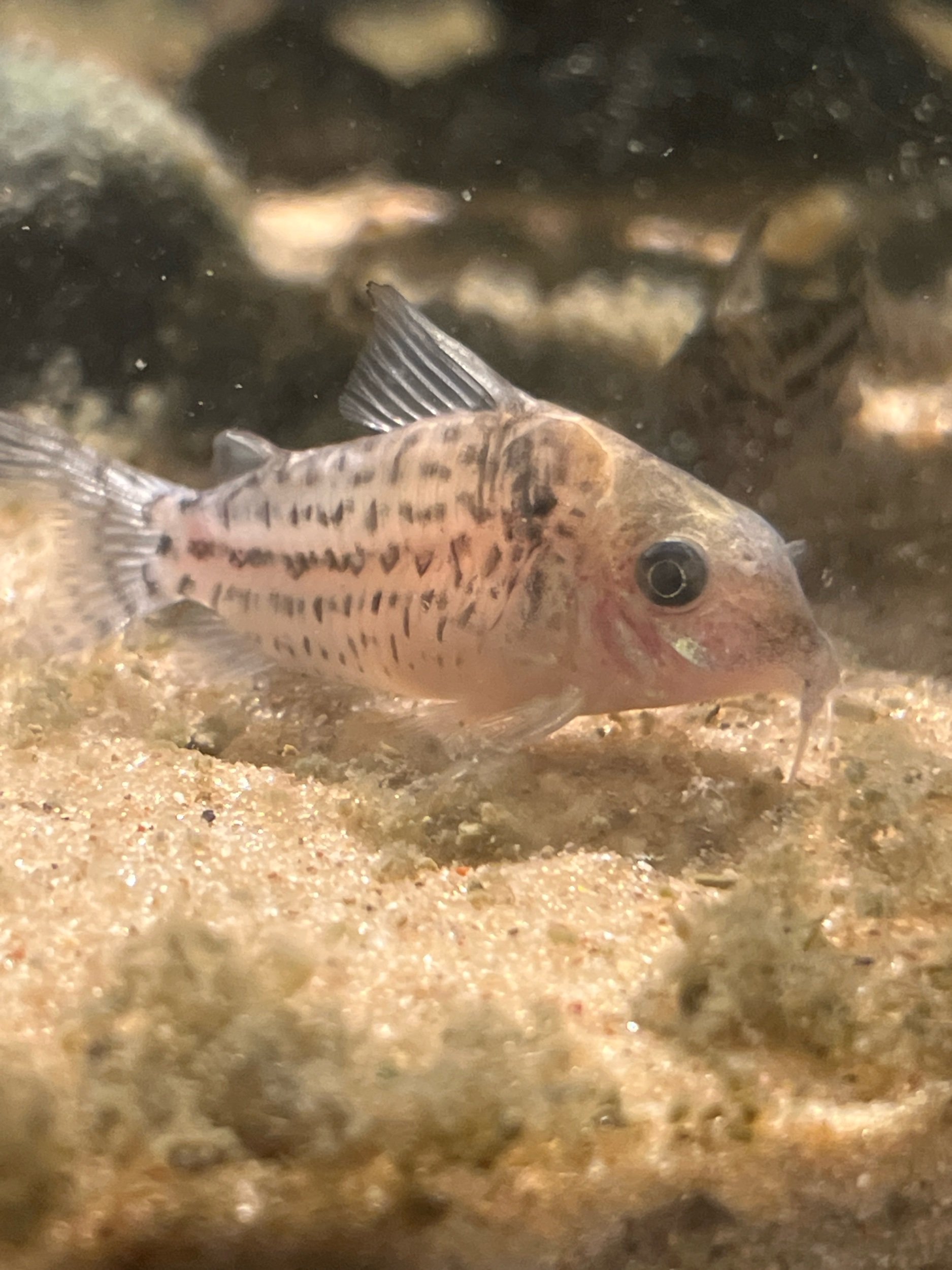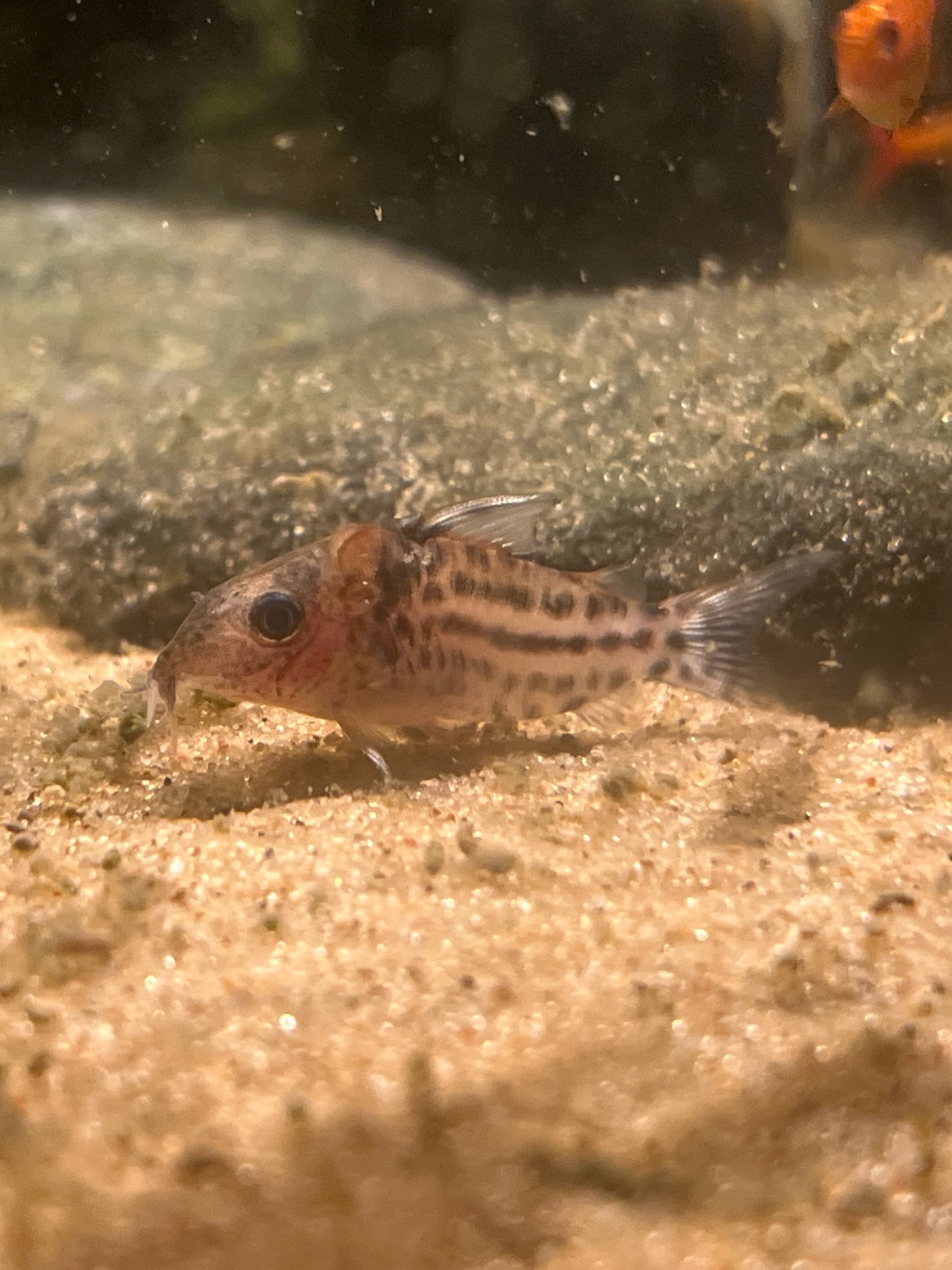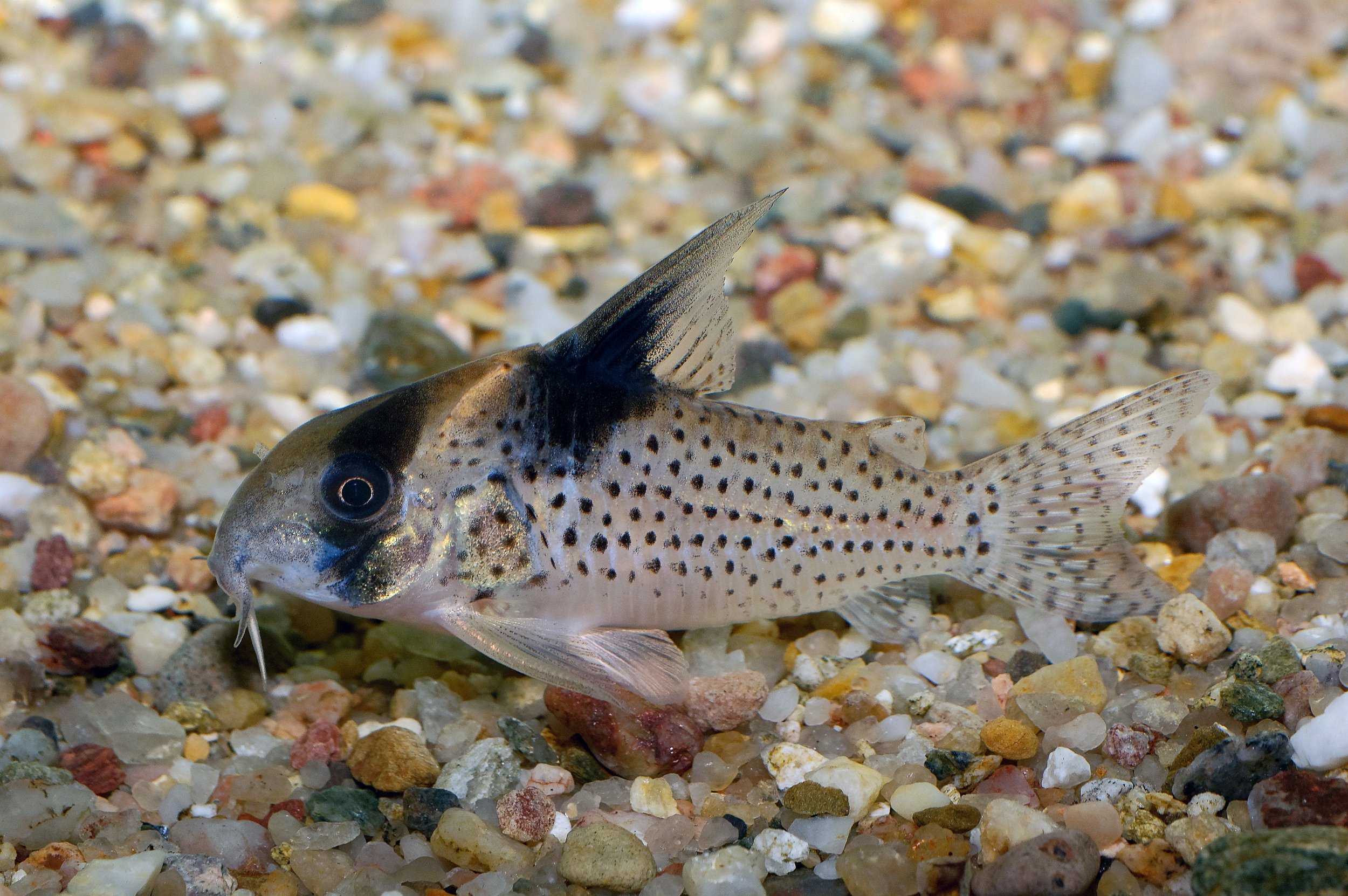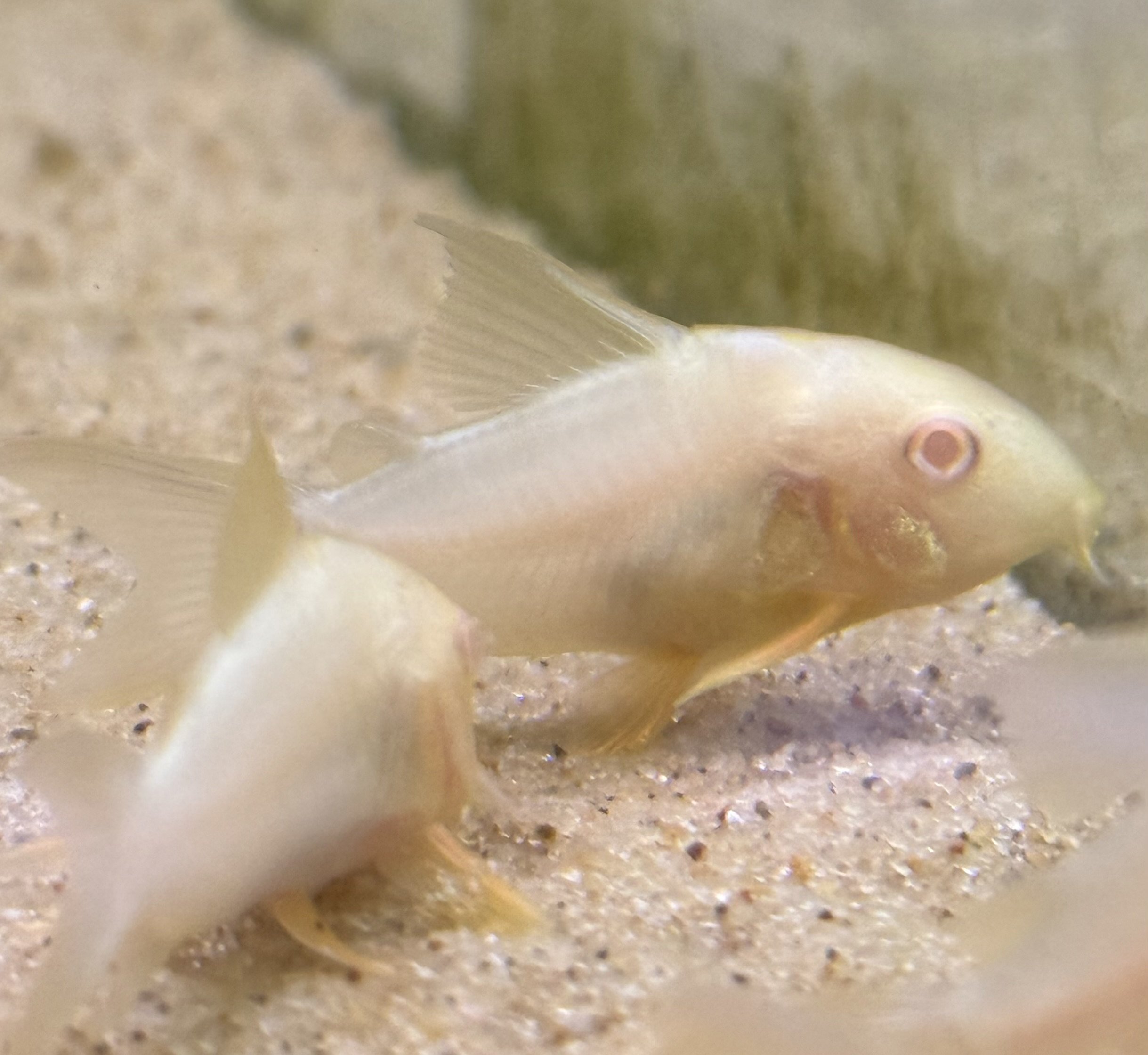 Image 1 of 2
Image 1 of 2

 Image 2 of 2
Image 2 of 2



Incolicana Cory XL
Corydoras incolicana is a lesser-known but captivating species of freshwater catfish belonging to the Corydoras genus. Native to the tributaries of the Rio Ucayali in Peru, this species is admired by aquarists for its peaceful demeanor, attractive markings, and suitability for community tanks. Like other Corydoras species, Corydoras incolicana is a bottom-dweller that thrives in well-planted aquariums with soft substrates, where it can forage for food.
Physically, Corydoras incolicana has a striking appearance characterized by a pale, silver-gray body adorned with darker markings. A prominent black stripe runs horizontally from the snout, through the eyes, and along the lateral line, tapering toward the tail. Additionally, the body is peppered with fine spots and blotches, giving the fish a marbled or mottled appearance. The fins are typically translucent with faint markings. Like other Corydoras species, Corydoras incolicana has a pair of sensitive barbels near its mouth, which it uses to search for food in the substrate. Adult specimens generally reach a length of about 2.5 inches (6 centimeters), making them well-suited for a range of aquarium sizes.
In the aquarium, Corydoras incolicana thrives in environments that replicate its natural habitat. A soft, sandy substrate is crucial, as these fish spend most of their time foraging along the bottom of the tank. Rough or jagged substrates can damage their delicate barbels, so smooth, fine sand is recommended. The tank should also be well-planted, with plenty of hiding spots such as driftwood, caves, and rocks, to provide security. Corydoras incolicana is a social species and should be kept in groups of at least six to encourage natural schooling behavior and reduce stress.
Water parameters for Corydoras incolicana should closely match the soft, slightly acidic conditions of their natural Peruvian habitat. They prefer water with a pH range of 6.0 to 7.5 and temperatures between 72 to 78°F (22 to 26°C). Clean, well-filtered water is essential for their health, as Corydoras species are sensitive to fluctuations in water quality. Regular water changes are also important to maintain stable conditions.
Feeding Corydoras incolicana is easy, as they are omnivorous and will accept a wide variety of foods. Sinking pellets or wafers designed for bottom-dwelling fish are a great staple for their diet. They also enjoy live or frozen foods such as bloodworms, brine shrimp, and daphnia. It's important to provide a varied diet to ensure their overall health and well-being. While these fish will help clean up uneaten food from the substrate, their diet should still be properly supplemented to meet their nutritional needs.
Breeding Corydoras incolicana in captivity is possible but can be challenging. Like other Corydoras species, they are egg-layers, and spawning can often be triggered by performing large water changes with cooler water, simulating the rainy season in their natural habitat. The female typically lays her eggs on flat surfaces like leaves, glass, or decorations. The eggs hatch in about 3 to 5 days, and the fry can be fed on infusoria or powdered fry food before transitioning to baby brine shrimp.
Overall, Corydoras incolicana is an excellent choice for aquarists looking for a peaceful, active, and visually appealing species. Their gentle nature, unique appearance, and compatibility with other peaceful species make them a valuable addition to community tanks. With the right care and attention to their specific needs, these beautiful fish can thrive in captivity and become a rewarding part of any well-maintained aquarium.
Corydoras incolicana is a lesser-known but captivating species of freshwater catfish belonging to the Corydoras genus. Native to the tributaries of the Rio Ucayali in Peru, this species is admired by aquarists for its peaceful demeanor, attractive markings, and suitability for community tanks. Like other Corydoras species, Corydoras incolicana is a bottom-dweller that thrives in well-planted aquariums with soft substrates, where it can forage for food.
Physically, Corydoras incolicana has a striking appearance characterized by a pale, silver-gray body adorned with darker markings. A prominent black stripe runs horizontally from the snout, through the eyes, and along the lateral line, tapering toward the tail. Additionally, the body is peppered with fine spots and blotches, giving the fish a marbled or mottled appearance. The fins are typically translucent with faint markings. Like other Corydoras species, Corydoras incolicana has a pair of sensitive barbels near its mouth, which it uses to search for food in the substrate. Adult specimens generally reach a length of about 2.5 inches (6 centimeters), making them well-suited for a range of aquarium sizes.
In the aquarium, Corydoras incolicana thrives in environments that replicate its natural habitat. A soft, sandy substrate is crucial, as these fish spend most of their time foraging along the bottom of the tank. Rough or jagged substrates can damage their delicate barbels, so smooth, fine sand is recommended. The tank should also be well-planted, with plenty of hiding spots such as driftwood, caves, and rocks, to provide security. Corydoras incolicana is a social species and should be kept in groups of at least six to encourage natural schooling behavior and reduce stress.
Water parameters for Corydoras incolicana should closely match the soft, slightly acidic conditions of their natural Peruvian habitat. They prefer water with a pH range of 6.0 to 7.5 and temperatures between 72 to 78°F (22 to 26°C). Clean, well-filtered water is essential for their health, as Corydoras species are sensitive to fluctuations in water quality. Regular water changes are also important to maintain stable conditions.
Feeding Corydoras incolicana is easy, as they are omnivorous and will accept a wide variety of foods. Sinking pellets or wafers designed for bottom-dwelling fish are a great staple for their diet. They also enjoy live or frozen foods such as bloodworms, brine shrimp, and daphnia. It's important to provide a varied diet to ensure their overall health and well-being. While these fish will help clean up uneaten food from the substrate, their diet should still be properly supplemented to meet their nutritional needs.
Breeding Corydoras incolicana in captivity is possible but can be challenging. Like other Corydoras species, they are egg-layers, and spawning can often be triggered by performing large water changes with cooler water, simulating the rainy season in their natural habitat. The female typically lays her eggs on flat surfaces like leaves, glass, or decorations. The eggs hatch in about 3 to 5 days, and the fry can be fed on infusoria or powdered fry food before transitioning to baby brine shrimp.
Overall, Corydoras incolicana is an excellent choice for aquarists looking for a peaceful, active, and visually appealing species. Their gentle nature, unique appearance, and compatibility with other peaceful species make them a valuable addition to community tanks. With the right care and attention to their specific needs, these beautiful fish can thrive in captivity and become a rewarding part of any well-maintained aquarium.
Corydoras incolicana is a lesser-known but captivating species of freshwater catfish belonging to the Corydoras genus. Native to the tributaries of the Rio Ucayali in Peru, this species is admired by aquarists for its peaceful demeanor, attractive markings, and suitability for community tanks. Like other Corydoras species, Corydoras incolicana is a bottom-dweller that thrives in well-planted aquariums with soft substrates, where it can forage for food.
Physically, Corydoras incolicana has a striking appearance characterized by a pale, silver-gray body adorned with darker markings. A prominent black stripe runs horizontally from the snout, through the eyes, and along the lateral line, tapering toward the tail. Additionally, the body is peppered with fine spots and blotches, giving the fish a marbled or mottled appearance. The fins are typically translucent with faint markings. Like other Corydoras species, Corydoras incolicana has a pair of sensitive barbels near its mouth, which it uses to search for food in the substrate. Adult specimens generally reach a length of about 2.5 inches (6 centimeters), making them well-suited for a range of aquarium sizes.
In the aquarium, Corydoras incolicana thrives in environments that replicate its natural habitat. A soft, sandy substrate is crucial, as these fish spend most of their time foraging along the bottom of the tank. Rough or jagged substrates can damage their delicate barbels, so smooth, fine sand is recommended. The tank should also be well-planted, with plenty of hiding spots such as driftwood, caves, and rocks, to provide security. Corydoras incolicana is a social species and should be kept in groups of at least six to encourage natural schooling behavior and reduce stress.
Water parameters for Corydoras incolicana should closely match the soft, slightly acidic conditions of their natural Peruvian habitat. They prefer water with a pH range of 6.0 to 7.5 and temperatures between 72 to 78°F (22 to 26°C). Clean, well-filtered water is essential for their health, as Corydoras species are sensitive to fluctuations in water quality. Regular water changes are also important to maintain stable conditions.
Feeding Corydoras incolicana is easy, as they are omnivorous and will accept a wide variety of foods. Sinking pellets or wafers designed for bottom-dwelling fish are a great staple for their diet. They also enjoy live or frozen foods such as bloodworms, brine shrimp, and daphnia. It's important to provide a varied diet to ensure their overall health and well-being. While these fish will help clean up uneaten food from the substrate, their diet should still be properly supplemented to meet their nutritional needs.
Breeding Corydoras incolicana in captivity is possible but can be challenging. Like other Corydoras species, they are egg-layers, and spawning can often be triggered by performing large water changes with cooler water, simulating the rainy season in their natural habitat. The female typically lays her eggs on flat surfaces like leaves, glass, or decorations. The eggs hatch in about 3 to 5 days, and the fry can be fed on infusoria or powdered fry food before transitioning to baby brine shrimp.
Overall, Corydoras incolicana is an excellent choice for aquarists looking for a peaceful, active, and visually appealing species. Their gentle nature, unique appearance, and compatibility with other peaceful species make them a valuable addition to community tanks. With the right care and attention to their specific needs, these beautiful fish can thrive in captivity and become a rewarding part of any well-maintained aquarium.







